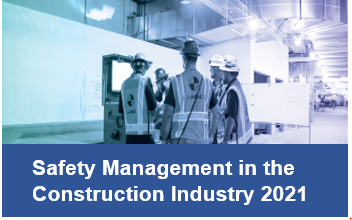New study reveals influence of pandemic, new tech and company size on construction safety management


COVID-19 and new technologies are creating significant changes in how contractors manage safety, according to a new study from Dodge Data & Analytics. There are stark variations in how companies of different sizes are responding, with small employers lagging behind their larger peers.
Safety Management in the Construction Industry 2021 SmartMarket Report, the fifth in this series, shows how contractors and workers are adapting well-established principles of safety management to respond to the pandemic and are beginning to take advantage of increased access to real-time data. The report was published with the support of the CPWR — The Center for Construction Research and Training (CPWR) and Newmetrix.
Safety Management in the Construction Industry 2021 documents how COVID-19 accelerated existing shifts in contractors’ approaches. More than one in three contractors (35%) increased online training over the past 12 months, and nearly two-thirds (63%) of contractors now use it. More than 75% of the contractors who reported using more online training attributed that growth either partly or completely to COVID-19. However, while 96% of large employers with 100 or more workers have developed a written plan to protect jobsite workers from the spread of COVID-19, only 57% of employers with less than 20 employees had written plans.
An even bigger trend resulting from COVID-19 is the greater use of health and wellness measures. While these measures have long been a part of construction safety, the study found that many new measures have been adopted during the pandemic. Nearly two-thirds (61%) of contractors plan to keep some of these measures after the pandemic subsides, although respondents varied widely in their views of which practices will continue.
The study benchmarks the current use of health and wellness programs for workers on the job site and in company offices. Between 40% to 50% of contractors offer their workers mental health services, including alcohol and substance abuse programs, but only about 25% offer stress management or smoking cessation programs. Again, large contractors were significantly more likely to take this step than small contractors. These statistics suggest both wide recognition of the value of these programs and opportunities for much wider adoption.
“COVID-19 has emphasized that worker safety and health are crucial to successful construction,” said Chris Trahan Cain, CPWR’s executive director. “This report shows that contractors of all sizes must continue addressing persistent concerns like falls and ergonomics at the same time they respond to COVID-19 through planning, training, and advances in technology.”
The report also shows that the construction industry continues to move towards a data-driven approach for managing safety.
- One in five contractors (19%) rank making better use of the safety data they currently collect as one of the top means of improving their safety program.
- A slightly higher share believes that the use of observational data from jobsite imagery (26%) and of predictive analytics (21%) is essential to a world-class safety program.
The study also points to the likelihood for wider adoption of a data-driven approach. Contractors identified several technologies as most likely to improve safety in the future, including wearable sensors, predictive analytics and visual monitoring with artificial intelligence (AI). Currently, only about 10% of contractors are using wearable sensors or predictive analytics, and only 5% use visual monitoring with AI. Forty-one percent of small employers do not currently use data for their safety programs, but 96% larger companies do. Overall, the share who expect to implement these technologies in the next three years is more than double those who currently do.
The study emphasizes that contractors are continuing their existing safety practices. Both the practices and the benefits from their use — including the ability to negotiate better insurance terms, improved standing in the industry and improved ability to bring in new work — remain remarkably consistent with previous SmartMarket Reports.
“Despite the new requirements and challenges brought about by having to deal with COVID-19, the study findings demonstrate contractor commitments to their top safety practices,” says Steve Jones, Senior Director of Industry Insights at Dodge Data & Analytics. “They still see that making these investments has positive implications not only for their workers but for their projects and their businesses.”
The full report is available for free download at www.construction.com.
